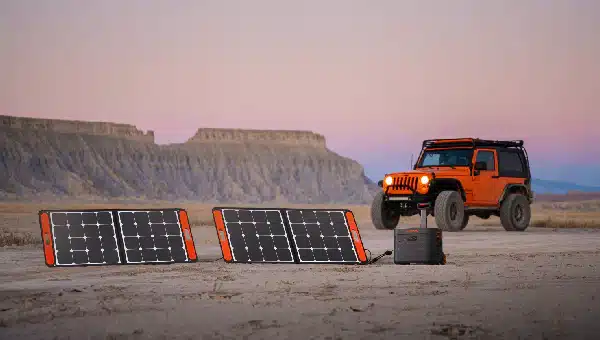
Are you ready to break free from the chains of conventional power outlets? If so, you’re in the right place. Solar portable power stations might be your ticket to that freedom. These innovative devices, you see, are transforming the way we use energy every day. They’ve become essential tools for camping trips, outdoor workshops, and emergency situations, offering us an unlimited supply of clean, renewable energy wherever we might need it.
The world of solar portable power stations, however, can be a bit overwhelming at first. With countless options available on the market, it’s easy to end up more confused than when you started. That’s where I come in. My aim is to demystify the ins and outs of these stellar powerhouses and guide you towards making the best choice for your needs.
You can rest assured that after reading this guide, you’ll have all the knowledge you need to harness the power of the sun – right in the palm of your hands. So, let’s get started on this journey towards sustainable power and portable freedom, shall we?
Let’s dive right into the world of solar portable power stations. These handy devices are essentially a portable battery system that you can charge using sunlight, which is perfect for camping, emergency situations or any other off-grid adventures. They’ve grown increasingly popular due to their efficiency and portability.
Each solar power station has a solar photovoltaic panel. This panel captures sunlight and converts it into usable electricity. This energy then gets stored in a battery for later use. It’s worth noting that the size and efficiency of the panel can impact the amount of power a station can generate and store.
Below are some features of a solar portable power station:
Let’s consider, for instance, two popular models: Jackery Explorer 500 and Goal Zero Yeti 200X.
| Model | Weight | Battery Capacity | Solar Panel Efficiency |
|---|---|---|---|
| Jackery Explorer 500 | 13.32 lbs | 518Wh | 85% |
| Goal Zero Yeti 200X | 5 lbs | 200Wh | 80% |
For the Jackery Explorer 500, I discovered that:
As for the Goal Zero Yeti 200X:
In summary, solar portable power stations allow you to harness the power of the sun and use it as electricity wherever you are. Though they might seem complex at first glance, a basic understanding of their components and their function can help demystify them.
When you’re on the prowl for the best solar portable power station, there’s a slew of factors that should weigh into your decision making process. You’ll need to consider both your specific needs and the unique qualities each solar power station brings to the table.
First up, let’s talk about capacity. It’s an essential factor. Basically, think of capacity as how much power the solar station can store. When it comes to capacity, bigger isn’t always better. Assess your needs. If you’re charging small devices like smartphones and cameras, a smaller capacity station could suffice. On the other hand, if you’re powering larger devices like laptops or camping appliances, you may need a higher capacity station.
Next on the agenda is the power output. While capacity tells us how much energy a station can store, power output reveals how much electricity it can output at once. One power station might have a larger capacity, but if it’s power output is low, it’ll take a longer while to charge devices.
Another major player is the station’s portability. After all, it’s in the name – ‘portable power station’. So, think about weight, size and even handle or strap design. You’ll want to ensure it’s practical to carry around especially if you’re planning to take it on camping trips or other outdoor adventures.
Now let me introduce two quality contenders available on Amazon:
In the end, the choice lies in your hands. What best caters to your needs? Remember, when it comes to choosing the best solar portable power station, it’s all about the balance of capacity, power output, and portability.
Learning to maximize a solar portable power station isn’t rocket science. With a few pointers, you’ll be running at peak efficiency in no time. One critical aspect is being aware of the energy consumption of your devices. Each gadget has a specific wattage and the sum of all connected devices should be less than the power station’s output. For those who are always on the move, choosing a lightweight and compact model might be the best option.
Let’s take a look at the following popular models from Amazon:
Charging your solar power station to the fullest before starting a trip is crucial. Remember that it takes time to charge via solar cells, especially on cloudy days or during nights when there’s no sunlight. Patience is key here. But if you’re in a more urgent situation, an AC wall outlet or your car’s battery could be alternate charging sources.
Maintenance-wise, solar panels do accumulate dust and dirt over time, which may affect their efficiency. Cleaning them regularly ensures that they’re absorbing sunlight at their maximum capacity.
Another crucial aspect is being aware of the temperature. High warmth can damage a solar power station. Always try to keep it in a cool shaded place, even while charging. Yes, it’s solar, but the station itself doesn’t have to be under direct sunlight!
To wrap things up, getting the most out of your solar portable power station comes down to understanding and acknowledging its limits, using it wise, maintenance and taking measures to protect it from extreme conditions. By following these tips, you’ll get the most out of your solar portable power station and you’ll be better prepared for your future adventures.
